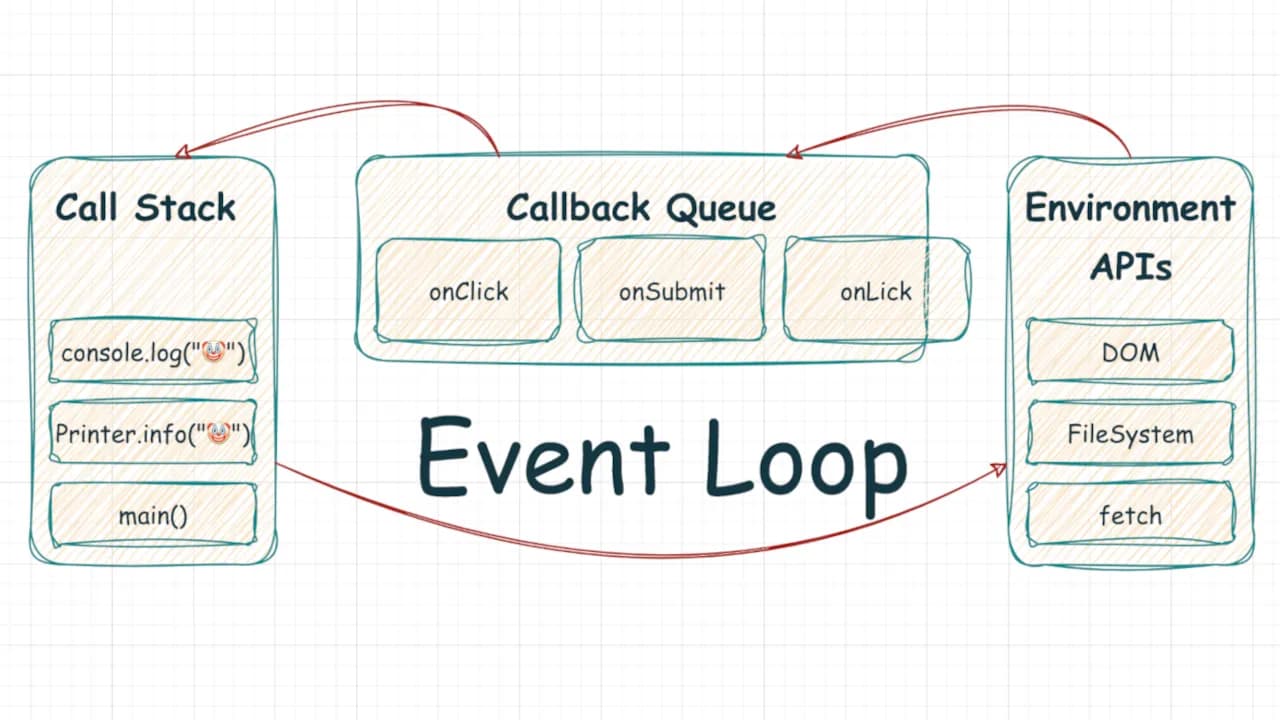JavaScript is often described as “single-threaded” and “asynchronous,” but what does that actually mean? How does JavaScript handle multiple tasks without blocking execution? In this post, we’ll break down how JavaScript executes code, what the event loop does, and how different environments like browsers, Node.js, Bun, and Deno manage async tasks.
Is JavaScript Single or Multi-Threaded?
JavaScript itself is single-threaded, meaning it can execute only one piece of code at a time in a single call stack. However, JavaScript can handle concurrency through asynchronous programming. This is possible because JavaScript doesn’t execute all tasks by itself—it delegates certain operations to the underlying runtime environment.
JavaScript’s Execution Model
JavaScript follows a run-to-completion model, meaning that once a function starts executing, nothing else can interrupt it until it finishes.
- Synchronous code runs sequentially, blocking further execution until it’s done.
-
Asynchronous code (e.g.,
setTimeout, Promises, async/await) is delegated to the environment, which schedules it to run later.
The Role of the JavaScript Engine
A JavaScript engine (e.g., V8 for Chrome and Node.js, SpiderMonkey for Firefox) executes JavaScript code. The engine itself:
- Parses and compiles JavaScript into machine code.
- Executes synchronous JavaScript line by line.
- Interacts with the event loop to handle async tasks.
However, the engine does not handle async tasks like timers, HTTP requests, or file system operations—that’s where the runtime environment comes in.
What is a JavaScript Runtime Environment?
A JavaScript runtime environment provides additional APIs that JavaScript itself does not have. These environments include:
- Browser Environment (Chrome, Firefox, Safari, Edge)
- Server-Side Runtimes (Node.js, Bun, Deno)
Each environment includes:
- A JavaScript Engine (e.g., V8 for Chrome and Node.js, JavaScriptCore for Safari, SpiderMonkey for Firefox).
-
Additional APIs (e.g.,
fetch(),setTimeout(),fs.readFile()). - An Event Loop to manage async tasks.
How the JavaScript Event Loop Works
The event loop is what enables JavaScript to handle asynchronous tasks while maintaining its single-threaded nature.
Event Loop Components
- Call Stack
- Stores the execution context of running functions.
- Functions run in a LIFO (Last In, First Out) manner.
- If a function is blocking, it prevents anything else from executing.
- Web APIs (in Browsers) / System APIs (in Node.js, Bun, Deno)
- Handle tasks like timers, HTTP requests, and file I/O.
- These tasks run in a separate thread managed by the runtime.
- Callback Queue
- Stores callbacks from async tasks that are ready to execute.
- Callbacks wait here until the call stack is empty.
- Microtask Queue
- Higher priority than the callback queue.
- Stores Promises and MutationObserver callbacks.
- Runs immediately after the current function finishes execution.
Step-by-Step Execution
- JavaScript starts executing synchronous code in the call stack.
-
If an asynchronous task (like
setTimeout) is encountered, it’s delegated to the runtime (browser or Node.js). - Once the async task is complete, its callback is added to the appropriate queue:
- Microtasks (Promises, async/await) run first.
- Callbacks from timers or I/O operations are added to the event queue.
- The event loop checks the call stack:
- If it’s empty, it moves the next task from the queue to the call stack.
- The process repeats indefinitely.
Asynchronous Examples
Example 1: setTimeout
jsconsole.log("Start");
setTimeout(() => {
console.log("Timeout callback");
}, 1000);
console.log("End");
Execution Flow:
-
"Start"is logged. -
setTimeout()is sent to the Web API (browser) or Timer API (Node.js). -
"End"is logged. -
After 1000ms, the callback
"Timeout callback"is added to the event queue. - Once the call stack is empty, the event loop moves the callback to the call stack.
Output:
Start
End
Timeout callback
Example 2: Promises (Microtasks)
jsconsole.log("Start");
setTimeout(() => console.log("Timeout callback"), 0);
Promise.resolve().then(() => console.log("Promise resolved"));
console.log("End");
Execution Flow:
-
"Start"is logged. -
setTimeout()is sent to the Web API. -
Promise.resolve().then(...)is added to the microtask queue. -
"End"is logged. -
Microtasks run before the event queue, so
"Promise resolved"is logged. -
The event loop picks up
"Timeout callback"from the event queue.
Output:
Start
End
Promise resolved
Timeout callback
JavaScript Runtime Environments
1. Browser Environment
-
Provides DOM APIs,
fetch(), WebSockets, IndexedDB, etc. - Uses a multi-threaded architecture (though JS itself is single-threaded).
-
Web APIs (like
setTimeout,fetch) run in separate threads.
2. Node.js
- Uses the V8 engine but has its own runtime.
-
Provides server-side APIs (
fs,http,process). - Uses libuv for async operations.
- Heavily uses event-driven programming.
3. Bun
- A faster alternative to Node.js.
- Built with JavaScriptCore (not V8).
- Supports native fetch, Web APIs, and built-in bundling.
- Optimized for speed, reducing overhead.
4. Deno
- Also uses V8 but provides a more secure runtime.
- Supports TypeScript out of the box.
- Uses Web APIs like fetch instead of Node.js-specific APIs.
- Runs with sandboxed security (e.g., file access must be explicitly granted).
Conclusion
- JavaScript itself is single-threaded, but its runtime enables asynchronous execution.
- The event loop ensures non-blocking execution by delegating tasks to the environment.
- The call stack, microtask queue, and event queue work together to manage async tasks.
- Different JavaScript runtimes (browser, Node.js, Bun, Deno) provide unique APIs and optimizations.
Understanding how JavaScript handles concurrency is crucial for writing efficient, non-blocking applications. Next time you’re working with async code, remember: JavaScript doesn’t do everything itself—it relies on the runtime environment!
The Most Helpful Video Contents
Album of the day:




